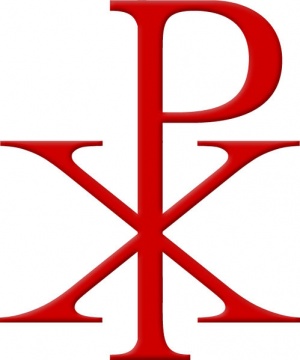Edictul de la Milano: Diferență între versiuni
(Pagină nouă: {{Traducere EN}}thumb|right|Hi Rho, literele inițiale ale numelui [[Iisus Hristos în greacă, pe care împăratul Constantin cel Mare le-a primit într-...) |
m (legături interne) |
||
| Linia 1: | Linia 1: | ||
{{Traducere EN}}[[Image:Labarum.jpg|thumb|right|Hi Rho, literele inițiale ale numelui [[Iisus Hristos]] în greacă, pe care împăratul [[Constantin cel Mare]] le-a primit într-o viziune dimpreună cu cuvintele "in hoc signo vinces" ("în acest semn vei învinge").]] | {{Traducere EN}}[[Image:Labarum.jpg|thumb|right|Hi Rho, literele inițiale ale numelui [[Iisus Hristos]] în greacă, pe care împăratul [[Constantin cel Mare]] le-a primit într-o viziune dimpreună cu cuvintele "in hoc signo vinces" ("în acest semn vei învinge").]] | ||
| − | '''Edictul de la Milano''' este o declarație imperială pe care a publicat-o împăratul [[Constantin cel Mare]] în anul 313, prin care toate religiile deveneau legale în Imperiul Roman, inclusiv | + | '''Edictul de la Milano''' este o declarație imperială pe care a publicat-o împăratul [[Constantin cel Mare]] în anul 313, prin care toate religiile deveneau legale în Imperiul Roman, inclusiv [[creștinism]]ul (și concepută probabil tocmai pentru a-l legaliza indirect). |
[[Paganism]], the official religion of the Empire and particularly of the army, was disestablished as such, and property which had previously been confiscated from Christians was returned. | [[Paganism]], the official religion of the Empire and particularly of the army, was disestablished as such, and property which had previously been confiscated from Christians was returned. | ||
| − | The Edict followed Constantine the Great's 311 conversion of his entire army preceding the Battle of Milvian Bridge, after which he gained control of the Western portion of the Empire. Before this battle, according to [[Eusebiu de Cezareea]], Constantine had a vision of either the [[ | + | The Edict followed Constantine the Great's 311 conversion of his entire army preceding the Battle of Milvian Bridge, after which he gained control of the Western portion of the Empire. Before this battle, according to [[Eusebiu de Cezareea]], Constantine had a vision of either the [[Cruce|semnul crucii]] or of a Chi Rho emblem (both symbolizing Christ), under which was written "in hoc signo vinces" (i.e., in this sign thou shalt conquer). |
| − | Unfortunately, the Edict did not end all persecution of Christians happily ever after; Licinius, the Eastern Emperor, soon marched against Constantine to gain control of the whole Empire for himself. In so doing, he made void the Edict in an attempt to gain the support of pagans, particularly those who composed much of the military. Constantine, however, eventually defeated and executed him. After Constantine, emperors such as [[ | + | Unfortunately, the Edict did not end all persecution of Christians happily ever after; Licinius, the Eastern Emperor, soon marched against Constantine to gain control of the whole Empire for himself. In so doing, he made void the Edict in an attempt to gain the support of pagans, particularly those who composed much of the military. Constantine, however, eventually defeated and executed him. After Constantine, emperors such as [[Iulian Apostatul]] also rose against Christianity. However, on the whole Constantine had turned the tide against Christian persecution. |
==Surse== | ==Surse== | ||
| Linia 12: | Linia 12: | ||
==A se vedea și== | ==A se vedea și== | ||
| − | *[[Constantin cel Mare | + | *[[Constantin cel Mare]] |
| − | ]] | + | |
[[Categorie:Istoria Bisericii]] | [[Categorie:Istoria Bisericii]] | ||
[[en:Edict of Milan]] | [[en:Edict of Milan]] | ||
[[fr:Édit de Milan]] | [[fr:Édit de Milan]] | ||
Versiunea de la data 3 septembrie 2012 14:18
| Acest articol (sau părți din el) este propus spre traducere din limba engleză!
Dacă doriți să vă asumați acestă traducere (parțial sau integral), anunțați acest lucru pe pagina de discuții a articolului. |

Edictul de la Milano este o declarație imperială pe care a publicat-o împăratul Constantin cel Mare în anul 313, prin care toate religiile deveneau legale în Imperiul Roman, inclusiv creștinismul (și concepută probabil tocmai pentru a-l legaliza indirect).
Paganism, the official religion of the Empire and particularly of the army, was disestablished as such, and property which had previously been confiscated from Christians was returned.
The Edict followed Constantine the Great's 311 conversion of his entire army preceding the Battle of Milvian Bridge, after which he gained control of the Western portion of the Empire. Before this battle, according to Eusebiu de Cezareea, Constantine had a vision of either the semnul crucii or of a Chi Rho emblem (both symbolizing Christ), under which was written "in hoc signo vinces" (i.e., in this sign thou shalt conquer).
Unfortunately, the Edict did not end all persecution of Christians happily ever after; Licinius, the Eastern Emperor, soon marched against Constantine to gain control of the whole Empire for himself. In so doing, he made void the Edict in an attempt to gain the support of pagans, particularly those who composed much of the military. Constantine, however, eventually defeated and executed him. After Constantine, emperors such as Iulian Apostatul also rose against Christianity. However, on the whole Constantine had turned the tide against Christian persecution.